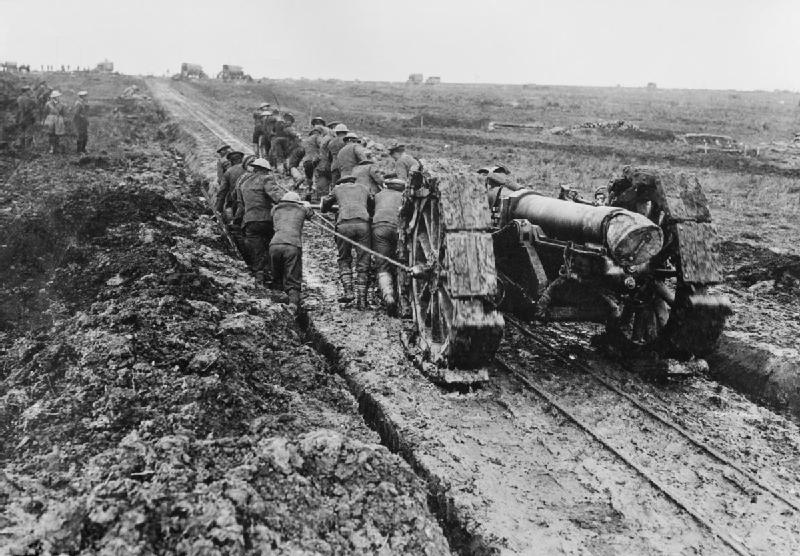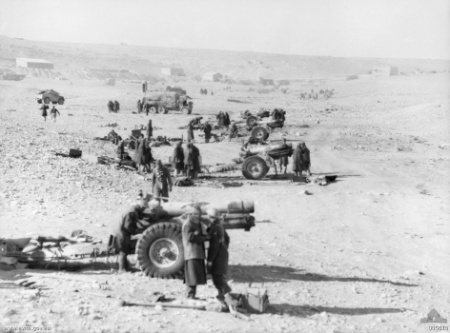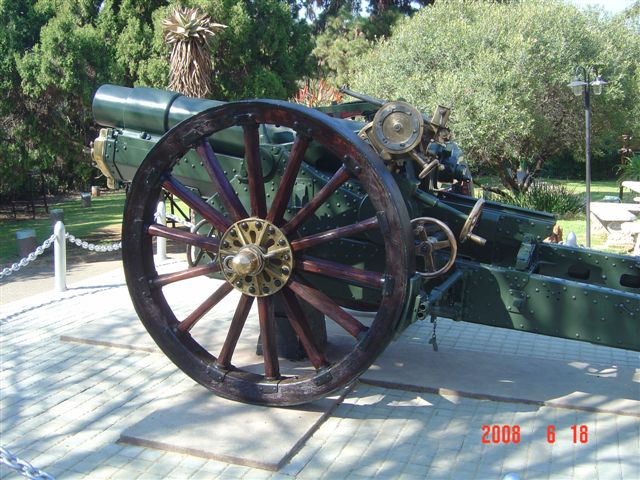BL 6-inch 26 Cwt Howitzer on:
[Wikipedia]
[Google]
[Amazon]
The Ordnance BL 6-inch 26cwt howitzer, officially BL 6-inch 26cwt howitzer Mk I on Carriage Mk I, was a British


 The howitzer was developed to replace the obsolescent 6 inch 25 cwt and 6 inch 30 cwt howitzers which were outclassed by German artillery such as the 15 cm schwere Feldhaubitze 13. Design began in January 1915, the first proof-firing occurred on 30 July 1915 and it entered service in late 1915.Hogg & Thurston 1972, Page 126-127 Its combination of firepower, range and mobility (for its day) made it one of the British Empire's most important weapons in World War I.
It was originally towed by horses but from 1916 onwards was commonly towed by the FWD 4 wheel drive 3 ton lorry as heavy field artillery. The wooden spoked wheels could be fitted with "girdles" for work in mud or sand to prevent them sinking. Towards the end of the war solid rubber tyres were fitted over the iron tyres on the wheel rims, giving the rims a heavier appearance. It fired 22.4 million rounds on the Western Front.Clarke 2005, page 37
The howitzer was developed to replace the obsolescent 6 inch 25 cwt and 6 inch 30 cwt howitzers which were outclassed by German artillery such as the 15 cm schwere Feldhaubitze 13. Design began in January 1915, the first proof-firing occurred on 30 July 1915 and it entered service in late 1915.Hogg & Thurston 1972, Page 126-127 Its combination of firepower, range and mobility (for its day) made it one of the British Empire's most important weapons in World War I.
It was originally towed by horses but from 1916 onwards was commonly towed by the FWD 4 wheel drive 3 ton lorry as heavy field artillery. The wooden spoked wheels could be fitted with "girdles" for work in mud or sand to prevent them sinking. Towards the end of the war solid rubber tyres were fitted over the iron tyres on the wheel rims, giving the rims a heavier appearance. It fired 22.4 million rounds on the Western Front.Clarke 2005, page 37
 During
During

Royal Artillery Museum, Woolwich, London
Army Memorial Museum, Waiouru, New ZealandRoyal Australian Artillery Museum
North Head, Sydney, Australia
Rovereto (Italy) *South Africa : The Imperial Government presented 6 howitzers to the Union of South Africa after World War I and the six South African Heavy Artillery Memorials were designed, commissioned and paid for by the South African Heavy Artillery Association to honour their fallen Comrades-in-Arms : Memorial to 71st (Transvaal) Siege Battery at Johannesburg Zoo (restored); 72nd (Griqualand West) Siege Battery at Clyde N Terry Museum, Kimberley; 73rd (Cape) Siege Battery at Company Gardens, Cape Town; 74th (Eastern Province) Siege Battery at National Museum, Bloemfontein (Restoration is about to begin, May 2009); 75th (Natal) Siege Battery, Warriors' Gate MOTH Shellhole, Old Fort Road, Durban; 125th (Transvaal) Siege Battery near the Union Buildings, Pretoria. These guns are being restored by the Gunner's Association of South Africa * National Museum of Military History, Saxonwold, Johannesburg, South Africa
The Central Museum of The Royal Regiment of Canadian Artillery, Shilo Manitoba
*Barrack Green Armouries, Belonging to and restored by 3rd Field Regt.(The Loyal Company), Saint John, New Brunswick
File:BL 6-inch 26 cwt howitzer 4 lb 11.5 oz cordite MD or RDB cartridge Mark II diagrams.jpg, 4lb 11½oz
British Artillery 1914-1919. Heavy Artillery. Osprey Publishing, Oxford UK, 2005
* General Sir
Handbook of the B.L. 6-inch 26-cwt. Mark I howitzer on Mark I travelling carriage, (land service), 1919.
Hosted online by State Library of Victoria, Australia
Gun drill for 6-inch B.L. 26-cwt howitzer Mark I carriage Mark I 1920
Hosted online by State Library of Victoria, Australia
Gun drill for B.L. 6-inch 26 cwt howitzer Mark 1 carriage Mark 1 1926
Hosted online by State Library of Victoria, Australia *
Video clips on YouTube
* Nigel F Evans
* W L Ruffell
* ttps://karaya.one/albums/index.php?/category/18 Walk around BL 6-inch 26-cwt howitzer WWI exposed to the Sacrario Militare di Redipuglia / Italy {{DEFAULTSORT:BL 06 inch 26 cwt howitzer World War I artillery of the United Kingdom World War II artillery of the United Kingdom World War I howitzers 152 mm artillery World War II howitzers
howitzer
The howitzer () is an artillery weapon that falls between a cannon (or field gun) and a mortar. It is capable of both low angle fire like a field gun and high angle fire like a mortar, given the distinction between low and high angle fire break ...
used during World War I
World War I or the First World War (28 July 1914 – 11 November 1918), also known as the Great War, was a World war, global conflict between two coalitions: the Allies of World War I, Allies (or Entente) and the Central Powers. Fighting to ...
and World War II
World War II or the Second World War (1 September 1939 – 2 September 1945) was a World war, global conflict between two coalitions: the Allies of World War II, Allies and the Axis powers. World War II by country, Nearly all of the wo ...
. The qualifier "26cwt" refers to the weight of the barrel and breech together which weighed .
History
World War I


 The howitzer was developed to replace the obsolescent 6 inch 25 cwt and 6 inch 30 cwt howitzers which were outclassed by German artillery such as the 15 cm schwere Feldhaubitze 13. Design began in January 1915, the first proof-firing occurred on 30 July 1915 and it entered service in late 1915.Hogg & Thurston 1972, Page 126-127 Its combination of firepower, range and mobility (for its day) made it one of the British Empire's most important weapons in World War I.
It was originally towed by horses but from 1916 onwards was commonly towed by the FWD 4 wheel drive 3 ton lorry as heavy field artillery. The wooden spoked wheels could be fitted with "girdles" for work in mud or sand to prevent them sinking. Towards the end of the war solid rubber tyres were fitted over the iron tyres on the wheel rims, giving the rims a heavier appearance. It fired 22.4 million rounds on the Western Front.Clarke 2005, page 37
The howitzer was developed to replace the obsolescent 6 inch 25 cwt and 6 inch 30 cwt howitzers which were outclassed by German artillery such as the 15 cm schwere Feldhaubitze 13. Design began in January 1915, the first proof-firing occurred on 30 July 1915 and it entered service in late 1915.Hogg & Thurston 1972, Page 126-127 Its combination of firepower, range and mobility (for its day) made it one of the British Empire's most important weapons in World War I.
It was originally towed by horses but from 1916 onwards was commonly towed by the FWD 4 wheel drive 3 ton lorry as heavy field artillery. The wooden spoked wheels could be fitted with "girdles" for work in mud or sand to prevent them sinking. Towards the end of the war solid rubber tyres were fitted over the iron tyres on the wheel rims, giving the rims a heavier appearance. It fired 22.4 million rounds on the Western Front.Clarke 2005, page 37
Interwar years
During the interwar period, the Carriage Mk I had its wooden spoked wheels augmented with rubber tires, these modified carriages were designated Carriage Mk IR. Later on, the carriages received modern steel wheels and pneumatic tyres, designated Carriage Mk IP.World War II
 During
During World War II
World War II or the Second World War (1 September 1939 – 2 September 1945) was a World war, global conflict between two coalitions: the Allies of World War II, Allies and the Axis powers. World War II by country, Nearly all of the wo ...
, its use was restricted after 1942 when the replacement BL 5.5 inch Medium Gun came into use but it was reintroduced in Burma
Myanmar, officially the Republic of the Union of Myanmar; and also referred to as Burma (the official English name until 1989), is a country in northwest Southeast Asia. It is the largest country by area in Mainland Southeast Asia and ha ...
due to a number of premature detonations in guns. After 1942, it remained in use in the Far East (mainly Burma) until the end of the war in 1945, when it was declared obsolete.
During the German conquest across Europe, German troops captured many howitzers from multiple countries. These captured examples received the designation 15.2 cm s.FH. 407(h) (Dutch howitzers), 15.2 cm s.FH. 410(b) (Belgian howitzers), 15.2 cm s.FH. 412(e) (British howitzers), 15.2 cm s.FH. 412(f) (French howitzers),Mistakenly attributed to the French Army. 15.2 cm s.FH. 412(i) (Italian howitzers), 15.2 cm s.FH. 444(r) (Soviet howitzers).
Variants
Gun variants: *Mark I – Only variant produced Carriage variants: *Mark I – Wooden wheels *Mark IR – Wooden wheels, rubber tyres *Mark IP – Steel wheels, pneumatic tyresSurviving examples

Royal Artillery Museum, Woolwich, London
Army Memorial Museum, Waiouru, New Zealand
North Head, Sydney, Australia
Rovereto (Italy) *South Africa : The Imperial Government presented 6 howitzers to the Union of South Africa after World War I and the six South African Heavy Artillery Memorials were designed, commissioned and paid for by the South African Heavy Artillery Association to honour their fallen Comrades-in-Arms : Memorial to 71st (Transvaal) Siege Battery at Johannesburg Zoo (restored); 72nd (Griqualand West) Siege Battery at Clyde N Terry Museum, Kimberley; 73rd (Cape) Siege Battery at Company Gardens, Cape Town; 74th (Eastern Province) Siege Battery at National Museum, Bloemfontein (Restoration is about to begin, May 2009); 75th (Natal) Siege Battery, Warriors' Gate MOTH Shellhole, Old Fort Road, Durban; 125th (Transvaal) Siege Battery near the Union Buildings, Pretoria. These guns are being restored by the Gunner's Association of South Africa * National Museum of Military History, Saxonwold, Johannesburg, South Africa
The Central Museum of The Royal Regiment of Canadian Artillery, Shilo Manitoba
*Barrack Green Armouries, Belonging to and restored by 3rd Field Regt.(The Loyal Company), Saint John, New Brunswick
Ammunition
British
World War I
Projectiles used in World War I weighed . A lighter long-range projectile was introduced in November 1918, too late to see service in the warcordite
Cordite is a family of smokeless propellants developed and produced in Britain since 1889 to replace black powder as a military firearm propellant. Like modern gunpowder, cordite is classified as a low explosive because of its slow burni ...
cartridge
File:6-inch BL or QF Mk XIIA common pointed artillery shell diagram.jpg, Common pointed 100lb shell Mark XIIA
File:BL 6 inch 26 cwt howitzer chemical shell light Mk VIII diagram.jpg, 100lb chemical shell Mark VIII
File:BL 6 inch 26 cwt howitzer high explosive light shell Mark XVI diagram.jpg, High explosive
An explosive (or explosive material) is a reactive substance that contains a great amount of potential energy that can produce an explosion if released suddenly, usually accompanied by the production of light, heat, sound, and pressure. An exp ...
100lb shell Mark XVI
World War II
See also
* BL 6 inch 30 cwt howitzer : British predecessor *List of howitzers
Howitzers are one of two primary types of field artillery. Historically, howitzers fired a heavy shell in a high-trajectory from a relatively short barrel and their range was limited but they were slightly more mobile than similar size field guns ...
Weapons of comparable role, performance and era
*Canon de 155 C modèle 1917 Schneider
The Canon de 155 C modèle 1917 Schneider (or Canon de 155 C Mle 1917 Schneider), often abbreviated as the ''C17S'', was a French howitzer designed by Schneider-Creusot, Schneider. It was essentially the ''Canon de 155 C modèle 1915 Schneider'' f ...
French equivalent
*15 cm sFH 13
The 15 cm schwere Feldhaubitze 13 (15 cm sFH 13), was a heavy field howitzer used by Germany in World War I and the beginning of World War II.
History
The gun was a development of the previous standard howitzer, the 15 cm sFH 02. ...
German equivalent
* 152 mm howitzer M1910 Russian equivalent
Notes
References
Bibliography
* Dale ClarkeBritish Artillery 1914-1919. Heavy Artillery. Osprey Publishing, Oxford UK, 2005
* General Sir
Martin Farndale
General Sir Martin Baker Farndale, (6 January 1929 – 10 May 2000) was a British Army officer who reached high office in the 1980s.
Military career
Educated at Yorebridge Grammar School, Askrigg, and the Royal Military Academy Sandhurst, Farn ...
, History of the Royal Regiment of Artillery. Western Front 1914-18. London: Royal Artillery Institution, 1986.
* I.V. Hogg & L.F. Thurston, British Artillery Weapons & Ammunition 1914-1918. London: Ian Allan, 1972.
External links
Handbook of the B.L. 6-inch 26-cwt. Mark I howitzer on Mark I travelling carriage, (land service), 1919.
Hosted online by State Library of Victoria, Australia
Gun drill for 6-inch B.L. 26-cwt howitzer Mark I carriage Mark I 1920
Hosted online by State Library of Victoria, Australia
Gun drill for B.L. 6-inch 26 cwt howitzer Mark 1 carriage Mark 1 1926
Hosted online by State Library of Victoria, Australia *
Video clips on YouTube
* Nigel F Evans
* W L Ruffell
* ttps://karaya.one/albums/index.php?/category/18 Walk around BL 6-inch 26-cwt howitzer WWI exposed to the Sacrario Militare di Redipuglia / Italy {{DEFAULTSORT:BL 06 inch 26 cwt howitzer World War I artillery of the United Kingdom World War II artillery of the United Kingdom World War I howitzers 152 mm artillery World War II howitzers